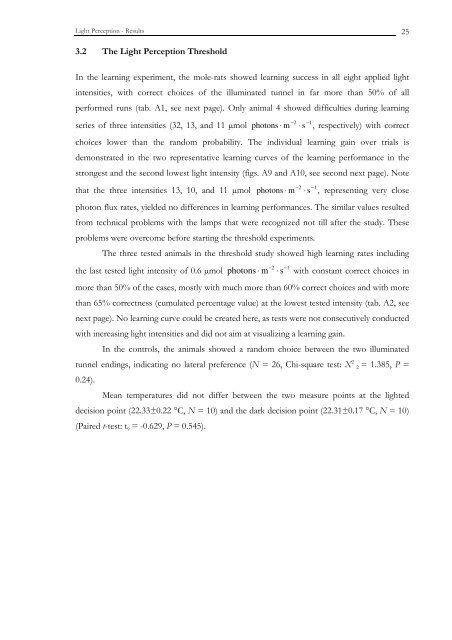Antigen Biotinylated Anti-Rabbit lgs Rabbit Primary Antiserum AB ...
Antigen Biotinylated Anti-Rabbit lgs Rabbit Primary Antiserum AB ...
Antigen Biotinylated Anti-Rabbit lgs Rabbit Primary Antiserum AB ...
You also want an ePaper? Increase the reach of your titles
YUMPU automatically turns print PDFs into web optimized ePapers that Google loves.
Light Perception - Results<br />
3.2 The Light Perception Threshold<br />
In the learning experiment, the mole-rats showed learning success in all eight applied light<br />
intensities, with correct choices of the illuminated tunnel in far more than 50% of all<br />
performed runs (tab. A1, see next page). Only animal 4 showed difficulties during learning<br />
series of three intensities (32, 13, and 11 µmol<br />
photons<br />
25<br />
−2 −1<br />
⋅ m ⋅ s , respectively) with correct<br />
choices lower than the random probability. The individual learning gain over trials is<br />
demonstrated in the two representative learning curves of the learning performance in the<br />
strongest and the second lowest light intensity (figs. A9 and A10, see second next page). Note<br />
that the three intensities 13, 10, and 11 µmol<br />
photons<br />
−2 −1<br />
⋅ m ⋅ s , representing very close<br />
photon flux rates, yielded no differences in learning performances. The similar values resulted<br />
from technical problems with the lamps that were recognized not till after the study. These<br />
problems were overcome before starting the threshold experiments.<br />
The three tested animals in the threshold study showed high learning rates including<br />
the last tested light intensity of 0.6 µmol<br />
photons<br />
−2 −1<br />
⋅ m ⋅ s with constant correct choices in<br />
more than 50% of the cases, mostly with much more than 60% correct choices and with more<br />
than 65% correctness (cumulated percentage value) at the lowest tested intensity (tab. A2, see<br />
next page). No learning curve could be created here, as tests were not consecutively conducted<br />
with increasing light intensities and did not aim at visualizing a learning gain.<br />
In the controls, the animals showed a random choice between the two illuminated<br />
tunnel endings, indicating no lateral preference (N = 26, Chi-square test: X 2<br />
2 = 1.385, P =<br />
0.24).<br />
Mean temperatures did not differ between the two measure points at the lighted<br />
decision point (22.33±0.22 °C, N = 10) and the dark decision point (22.31±0.17 °C, N = 10)<br />
(Paired t-test: t 9 = -0.629, P = 0.545).

















